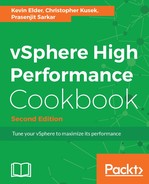Let's get started:
-
Create a VM storage policy. While in vSphere Web Client, click on the Home icon and select Policies and Profiles. This will take you to the Policies and Profiles view. Then, select VM Storage Policies from the left sidebar. This will take you to the VM Storage Profiles view:

Now we can see the default VM storage policies as shown in the image below:

- The next step is to start adding a new VM storage policy. To do this, select Create VM Storage Policy. If we stick to the gold/silver/bronze example, here is how you would create a Gold user-defined storage policy:

- If you create additional storage capabilities, you can use them to classify different types of storage.
- The next page of the VM storage policy is Policy Structure, which provides a breakdown of how the levels of service are applied to the VMs:

- Through the Common Rules option, you can provide additional rules applicable to encryption, I/O control, and caching. These are user-configurable storage policy components you can establish:

- Rule-set 1 is where we define the rule sets applicable to the VM storage policy; in this example, we use tag-based placement:

- The tag used for placement will be based on the datastore speed:

- In our example, this category will tag storage based on it being present under All flash datastore:

- After selecting Rule-set 1, our Gold VM storage policy is configured to be usable, based on the VMs tagged with the All flash datastore tag for datastore speed:

- As we proceed, the Storage compatibility screen shows which storage is compatible with this policy:

- Then, we proceed to the final screen to finish and create the Gold policy:

- Upon completion, we have a new VM storage policy named Gold, which we can assign to our VMs:

- Using the VM storage policy, at this point, the profile is created and the user-defined capabilities are added to the datastore. Now we can use the profile to select the correct storage for the VM. The profile is automatically attached to the VM during the deployment phase. Later, we can check whether the datastore on which the VM is placed has the same capabilities as the profile. If it does, then the VM is said to be compliant. If it does not, then the VM is said to be non-compliant.
VM Storage Policies can be used during deployment or migrations or can be attached on the fly.
